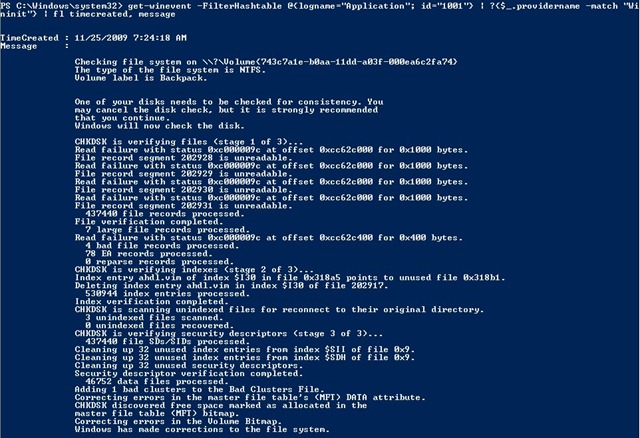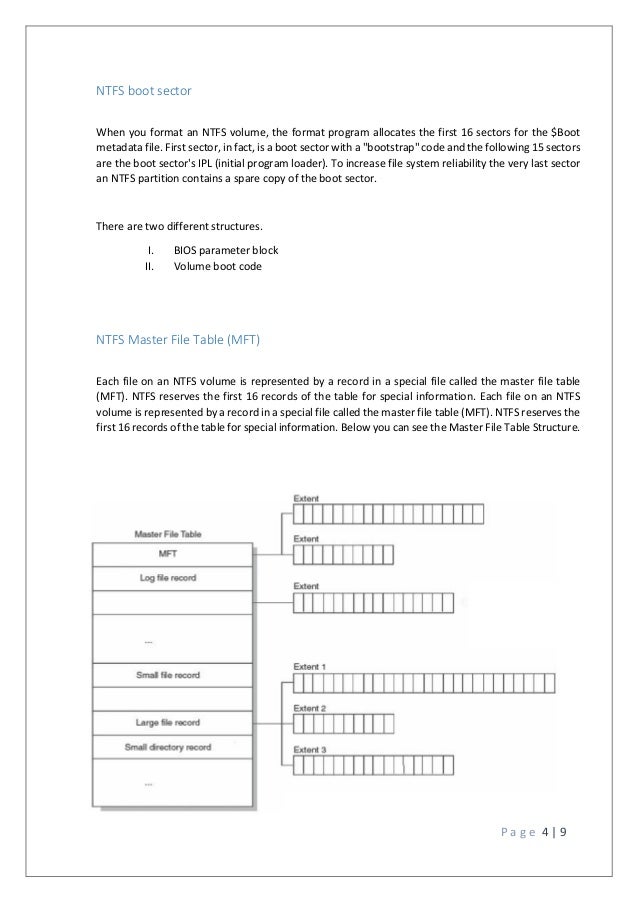-
Vista `Ntfs Volume Log
Windows 8 volume compatibility considerations with prior versions of Windows - Tech. Net Articles - United States (English)Summary. This article describes several design changes introduced with Windows 8 which change the supported boot configurations for users which utilize multiple operating systems on their personal computer. NTFS volumes between Windows 8 and a prior version of Windows. Background. As detailed in the Building Windows 8 blog, Windows 8 introduced much faster boot times as a result of the introduction of “Hybrid.
Windows 8 volume compatibility considerations with prior versions of Windows - Tech. Net Articles - United States (English)Summary. This article describes several design changes introduced with Windows 8 which change the supported boot configurations for users which utilize multiple operating systems on their personal computer. NTFS volumes between Windows 8 and a prior version of Windows. Background. As detailed in the Building Windows 8 blog, Windows 8 introduced much faster boot times as a result of the introduction of “Hybrid.
Boot”. With the new model, Windows 8 will log off active users, but instead of terminating the kernel session, the system is hibernated. This means that the memory state of running system processes, devices, and.
Hiberfile instead of being dismounted and shutdown. On resume, the Hiberfile is read which resumes the memory state, drivers are initialized, and the user session is prepared. By not having to perform a full boot, the time necessary. Also with Windows 8, there has been work done in the NT File System (NTFS) to reduce the I/O count of log file writes.
This method helps ensure consistency of on- disk metadata structures in the event of an unexpected unclean dismount (for example caused by a power interruption). However. a side effect of this change is that the new log format is unrecognizable with prior versions of Windows, which may result in a prior version of NTFS marking the volume as corrupt (since the contents of the log is in an unrecognized format). This will trigger.
To help prevent prior versions of Windows mounting a NTFS volume with the new log file version, we’ve added logic to the NTFS driver in Windows 8 which does the following: When an NTFS volume is cleanly dismounted (such as on a full shutdown, a reboot, or a safe remove), NTFS will “downgrade” the log file structure and version number to one that is recognized by all prior versions of Windows. This helps ensure. NTFS volume is cleanly removed from Windows 8 for use in another operating system, it can be attached without the NTFS volume being marked as corrupted.
This helps ensure that by using the new log file structure in Windows 8, your device will operate with optimal performance, and with potentially reduced power consumption. NTFS will also upgrade the log file structure and version of any internally- attached.
NOTE: Most USB Flash keys or Flash Media Cards with a caching policy set to “Optimize for Quick Removal” will not be upgraded to the new log structure and version number and do not have the potential. These devices typically report themselves as “Removable Media” and “Hot- Pluggable”. Impact to Windows Boot Scenarios. When a system with multiple versions of Windows installed is resumed from a Hybrid Boot state, the boot process will fully restore Windows 8 and remount previously active volumes. If the user selects an alternate version, the system is rebooted (which allows for active file systems to dismount and in turn downgrade the log file structure and version to one that is.

Windows) and the system will load the desired version. In most scenarios, this will not result in a previous version of Windows mounting a NTFS volume with an unrecognized log file structure and version number. However, as part of the design of Hybrid Boot, the Windows 8 kernel is not fully shutdown unless a restart is requested, thus any mounted file systems do not have an opportunity to. Hibernated. As a result, active file systems will not be down- graded to the compatible log version 1. Hibernate. Thus, removing a physical drive containing active file systems from a Windows 8 machine. Hibernated, and connecting that drive to a prior version of Windows will result in the volume being marked as corrupted. A full chkdsk run will be required to clear the corrupted state of the volume, which will return it to a healthy.

If you anticipate that you will be physically moving storage devices with a caching policy set to “Optimize for Performance”, or storage devices attached through SATA or SAS between Windows 8 and a prior version of Windows, it. Hybrid Boot, or to set a registry key to prevent NTFS from upgrading the Logfile structure and version number to 2. Details on how either of these procedures, how you can determine if your volume has been.

How can I view a dump of a NTFS.
100% Disk Activity : Svchost - NTFS Volume Log File Mini Spy. China experimenting with its own cryptocurrency · in Front Page News. 1 Reply Shiranui; Google wants.



- Optimize NTFS hard disk performance. This can cause a bottleneck when listing the volume contents because NTFS maintains a.
- On a computer that is running Windows Vista or Windows Server 2008, the Ntfs.sys driver takes a long time (several seconds or minutes) to mount a large volume.
- Windows Vista; Performance & system failures; 9634 views Is it good for the disk to have so much activity? JoeGu asked on.
- Using a hex-editor to mount a NTFS volume, I've found an offset within the volume containing data I'm interested in. How can I figure out the full path/name of the.

Logfile structure, and how to determine your storage device’s caching policy follows in this article. To ensure that the Windows 8 boot loader is utilized, ensure that you install Windows 8 on your system. Windows. Utilizing a non- Windows 8 boot loader to boot Windows 8 is not supported. This may result in the Windows 8 boot loader being overwritten, and replaced with the boot loader from the prior version of Windows. If you are moving storage devices with a caching policy to “Optimize for Quick Removal”, and which are attached through USB, between Windows 8 and a prior version of Windows, you do not need to disable Hybrid Boot, or disable NTFS Log file upgrade. Instead. it is recommended that prior to disconnecting the device from your system, you utilize the Safe Removal mechanism in the Windows Notification Tray.
NTFS will not upgrade the Log file structure and version number on these types. Windows 8. With Hybrid Boot enabled in Windows 8, a “Shutdown” will cause the system to Hibernate.
As detailed in Microsoft KB < placeholder for article publishing> , it is not recommended that you remove a storage device from a Hibernated system, attach it to. Windows 8), reattach the device on the Hibernated system, and resume the system.
If you are intending to remove a storage device from the system, ensure that you first utilize the Safe Removal. Windows Notification Tray. Detailed Resolution Steps.
Determining. if your volume has been upgraded to Logfile version 2. Important! This section, method, or task contains steps that can potentially change key file system behavior. Therefore, make sure that you follow these steps carefully.
Right click the “cmd” icon, and at the bottom of the screen, click “Run as Administrator”. Type “fsutil fsinfo ntfsinfo < the drive letter of your volume”; example: fsutil fsinfo ntfsinfo C.
You should see output similar to the below. This section, method, or task contains steps that can potentially change key system behavior and settings. Therefore, make sure that you follow these steps carefully. Right click the “devmgmt” icon, and at the bottom of the screen, click “Run as Administrator”. Navigate to the “Disk drives” item, and expand it to detail all of the storage devices attached to the system. This specific device is a USB- attached Hard Disk Drive, which by default has a property to optimize for Quick Removal. It is recommended that prior to disconnecting the device from your system, you utilize the Safe Removal mechanism in the Windows Notification.
Tray. Disabling Windows Hybrid Boot. To disable Windows Hybrid Boot, and to have your system perform a full shutdown upon either pressing the Power Button or clicking the “Shutdown” option in the Charms bar, please follow the below steps. Note: These steps are only applicable to systems running Windows 8. Open the Start Screen by pressing the Windows Key or by navigating to the top right corner of your screen, summoning the Charms bar, and clicking the Windows icon. Click “Settings” on the right. Click “Change what the power buttons do”. The below screen should be presented to you.
You may need to provide Administrative permissions to change the settings. Press “Save changes” and Close the Window. Disabling Hybrid Boot. Disabling NTFS Log File Upgrade.
Important! This section, method, or task contains steps that tell you how to modify the registry. However, serious problems might occur if you modify the registry incorrectly. Therefore, make sure that you follow these steps carefully.
For. added protection, back up the registry before you modify it. Then, you can restore the registry if a problem occurs. For more information about how to back up and restore the registry, click the following article number to view the article in the Microsoft. Knowledge Base: 3. How to back up and restore the registry in Windows. Note: These steps are only applicable to systems running Windows 8 or Windows Server 2. To turn off the behavior of NTFS upgrading the log file structure and version number to 2.
NTFS volume in Windows 8, please follow the below steps. Note that this registry key does not persist the upgrade behavior to the volume, it only. NTFS driver on the local system. Open the Start Screen by pressing the Windows Key or by navigating to the top right corner of your screen, summoning the Charms bar, and clicking the Windows icon. If it does not exist, create it. Resetting the value to zero will return the system to the default behavior to upgrade. Logfile structure and version number to 2.
Close the Registry Editor and perform a system Restart (not Shutdown) to downgrade all mounted NTFS volumes to a log file structure and version number compatible with prior versions of Windows. Upon the next boot of Windows 8, NTFS will no longer upgrade.
-
Commentaires
